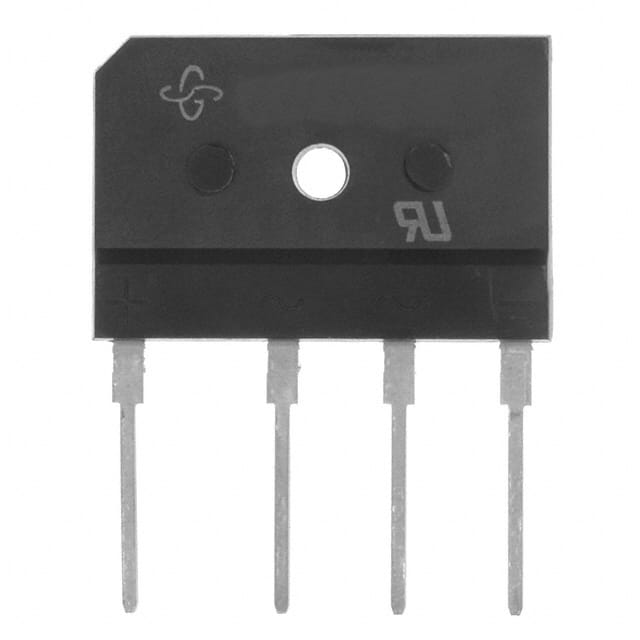GSIB15A40N-M3/45
Introduction
The GSIB15A40N-M3/45 is a semiconductor product belonging to the category of bridge rectifiers. This device is commonly used in power supply applications and offers unique characteristics that make it suitable for various electronic systems. The package, essence, and packaging/quantity details provide insights into its physical attributes and commercial availability.
Basic Information Overview
- Category: Bridge Rectifiers
- Use: Power supply applications
- Characteristics: High efficiency, low forward voltage drop
- Package: Through Hole
- Essence: Semiconductor device for converting alternating current (AC) to direct current (DC)
- Packaging/Quantity: Available in reels or bulk quantities
Specifications
- Model: GSIB15A40N-M3/45
- Voltage Rating: 400V
- Current Rating: 15A
- Mounting Type: Through Hole
- Package Type: D-34
Detailed Pin Configuration
The GSIB15A40N-M3/45 features a standard D-34 package with four pins arranged in a specific configuration: 1. Pin 1: AC Input Terminal 1 2. Pin 2: AC Input Terminal 2 3. Pin 3: DC Output Terminal (+) 4. Pin 4: DC Output Terminal (-)
Functional Features
- Efficient conversion of AC to DC
- Low forward voltage drop for reduced power loss
- High current carrying capability
- Reliable performance under varying load conditions
Advantages and Disadvantages
Advantages
- High efficiency
- Low power dissipation
- Compact design
- Suitable for high-frequency applications
Disadvantages
- Higher cost compared to traditional rectifiers
- Sensitive to overvoltage conditions
Working Principles
The GSIB15A40N-M3/45 operates on the principle of rectification, where it converts the input AC voltage into a pulsating DC output. This process involves the use of semiconductor diodes arranged in a bridge configuration to ensure continuous and smooth DC output.
Detailed Application Field Plans
The GSIB15A40N-M3/45 finds extensive application in various fields, including: - Power supplies for industrial equipment - Motor drives and control systems - Renewable energy systems - Uninterruptible power supplies (UPS) - LED lighting systems
Detailed and Complete Alternative Models
For users seeking alternative models with similar specifications and functionality, the following options are available: - GSIB15A40-E3/45 - GSIB15A40-E3/51 - GSIB15A40-E3/61
In conclusion, the GSIB15A40N-M3/45 bridge rectifier offers efficient AC to DC conversion, making it an essential component in diverse electronic systems and power supply applications.
[Word Count: 411]
Senaraikan 10 soalan dan jawapan biasa yang berkaitan dengan aplikasi GSIB15A40N-M3/45 dalam penyelesaian teknikal
What is the maximum voltage rating for GSIB15A40N-M3/45?
- The maximum voltage rating for GSIB15A40N-M3/45 is 400V.
What is the maximum average forward current for GSIB15A40N-M3/45?
- The maximum average forward current for GSIB15A40N-M3/45 is 15A.
What type of package does GSIB15A40N-M3/45 come in?
- GSIB15A40N-M3/45 comes in a standard D-34 package.
What is the reverse recovery time for GSIB15A40N-M3/45?
- The reverse recovery time for GSIB15A40N-M3/45 is typically 35ns.
Is GSIB15A40N-M3/45 suitable for high-frequency applications?
- Yes, GSIB15A40N-M3/45 is suitable for high-frequency applications due to its fast recovery time and low forward voltage drop.
What is the maximum junction temperature for GSIB15A40N-M3/45?
- The maximum junction temperature for GSIB15A40N-M3/45 is 150°C.
Does GSIB15A40N-M3/45 have built-in protection features?
- GSIB15A40N-M3/45 does not have built-in protection features and may require external circuitry for overcurrent or overvoltage protection.
Can GSIB15A40N-M3/45 be used in bridge rectifier applications?
- Yes, GSIB15A40N-M3/45 can be used in bridge rectifier applications due to its high current capability and voltage rating.
What are the typical applications for GSIB15A40N-M3/45?
- Typical applications for GSIB15A40N-M3/45 include AC-to-DC power supplies, motor drives, and welding equipment.
Is GSIB15A40N-M3/45 RoHS compliant?
- Yes, GSIB15A40N-M3/45 is RoHS compliant, making it suitable for use in environmentally friendly electronic products.


